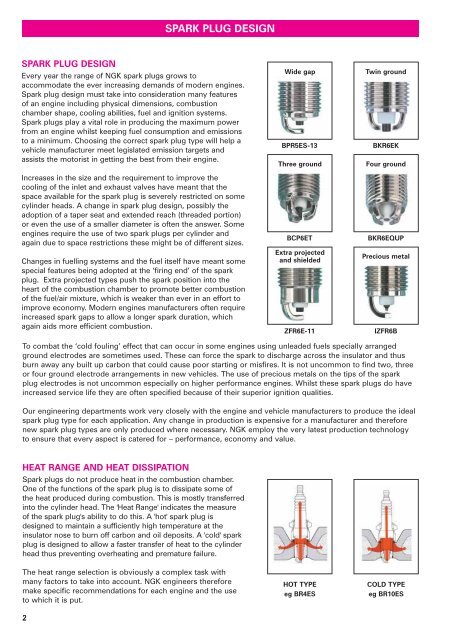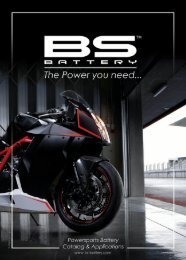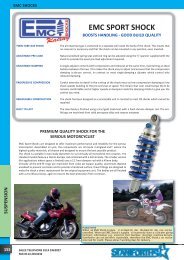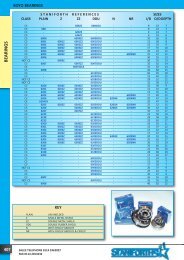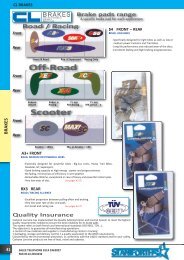Create successful ePaper yourself
Turn your PDF publications into a flip-book with our unique Google optimized e-Paper software.
SPARK PLUG DESIGN<br />
SPARK PLUG DESIGN<br />
Every year the range of NGK spark plugs grows to<br />
accommodate the ever increasing demands of modern engines.<br />
Spark plug design must take into consideration many features<br />
of an engine including physical dimensions, combustion<br />
chamber shape, cooling abilities, fuel and ignition systems.<br />
Spark plugs play a vital role in producing the maximum power<br />
from an engine whilst keeping fuel consumption and emissions<br />
to a minimum. Choosing the correct spark plug type will help a<br />
vehicle manufacturer meet legislated emission targets and<br />
assists the motorist in getting the best from their engine.<br />
Increases in the size and the requirement to improve the<br />
cooling of the inlet and exhaust valves have meant that the<br />
space available for the spark plug is severely restricted on some<br />
cylinder heads. A change in spark plug design, possibly the<br />
adoption of a taper seat and extended reach (threaded portion)<br />
or even the use of a smaller diameter is often the answer. Some<br />
engines require the use of two spark plugs per cylinder and<br />
again due to space restrictions these might be of different sizes.<br />
Changes in fuelling systems and the fuel itself have meant some<br />
special features being adopted at the ‘firing end’ of the spark<br />
plug. Extra projected types push the spark position into the<br />
heart of the combustion chamber to promote better combustion<br />
of the fuel/air mixture, which is weaker than ever in an effort to<br />
improve economy. Modern engines manufacturers often require<br />
increased spark gaps to allow a longer spark duration, which<br />
again aids more efficient combustion.<br />
Wide gap<br />
BPR5ES-13<br />
Three ground<br />
BCP6ET<br />
Extra projected<br />
and shielded<br />
ZFR6E-11<br />
Twin ground<br />
BKR6EK<br />
Four ground<br />
BKR6EQUP<br />
Precious metal<br />
IZFR6B<br />
To combat the ‘cold fouling’ effect that can occur in some engines using unleaded fuels specially arranged<br />
ground electrodes are sometimes used. These can force the spark to discharge across the insulator and thus<br />
burn away any built up carbon that could cause poor starting or misfires. It is not uncommon to find two, three<br />
or four ground electrode arrangements in new vehicles. The use of precious metals on the tips of the spark<br />
plug electrodes is not uncommon especially on higher performance engines. Whilst these spark plugs do have<br />
increased service life they are often specified because of their superior ignition qualities.<br />
Our engineering departments work very closely with the engine and vehicle manufacturers to produce the ideal<br />
spark plug type for each application. Any change in production is expensive for a manufacturer and therefore<br />
new spark plug types are only produced where necessary. NGK employ the very latest production technology<br />
to ensure that every aspect is catered for – performance, economy and value.<br />
HEAT RANGE AND HEAT DISSIPATION<br />
Spark plugs do not produce heat in the combustion chamber.<br />
One of the functions of the spark plug is to dissipate some of<br />
the heat produced during combustion. This is mostly transferred<br />
into the cylinder head. The 'Heat Range' indicates the measure<br />
of the spark plug's ability to do this. A 'hot' spark plug is<br />
designed to maintain a sufficiently high temperature at the<br />
insulator nose to burn off carbon and oil deposits. A 'cold' spark<br />
plug is designed to allow a faster transfer of heat to the cylinder<br />
head thus preventing overheating and premature failure.<br />
The heat range selection is obviously a complex task with<br />
many factors to take into account. NGK engineers therefore<br />
make specific recommendations for each engine and the use<br />
to which it is put.<br />
2<br />
HOT TYPE<br />
eg BR4ES<br />
COLD TYPE<br />
eg BR10ES


